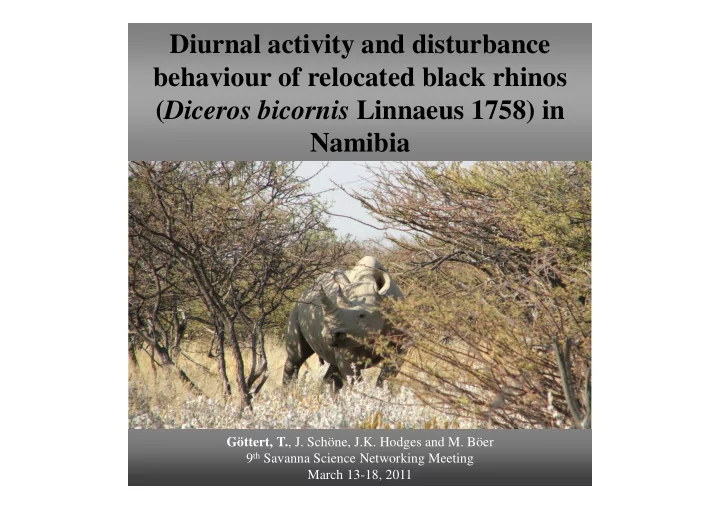

Diurnal activity and disturbance behaviour of relocated black rhinos ( Diceros bicornis Linnaeus 1758) in Namibia Göttert, T. , J. Schöne, J.K. Hodges and M. Böer 9 th Savanna Science Networking Meeting March 13-18, 2011
Black rhinoceros Diceros bicornis Linnaeus 1758 Number of rhino individuals: 1960: 100,000 1995: 2,410 2007: 4,180 Critically Endangered (2008) IUCN (2010) IUCN. 2010. IUCN Red List of Threatened Species. Version 2010.3. http://www.iucnredlist.org. Accessed Sep. 03, 2010.
Study area Namibia Etosha National Park 0 500km 0 100 km Etosha Heights / Moesamoeroep complex ● ● ● ● ● � ● ● ● ● ● � " ● ● ● ● ● ● ● ● ● ● ● ● □ ● ● � ● ● 5 km 0 10 N Etosha calcrete Otavi dolomite ● Size = 368 km 2 water area Black rhino starter group Subad. Subad. Adult Subad. Subad. Adult ♂ 1 ♂ 2 ♂ ♀ 1 ♀ 2 ♀ App. age 2.5 5 11 3 3 12 (years) Capture site farm farm ENP ENP ENP ENP Site distance 231 231 101 132 137 140 (km)
Data collection VHF radio telemetry Study period: Mar 2005 - Feb 2007 380 observation days 1,070 activity readings on six rhinos (136 - 288 readings / rhino) 246 sightings at 198 locations
(Adopted from Kiwia 1986) % Activity 2005 dry season 2005/2006 wet season 100 * 80 * * 60 40 20 0 n=59 n=41 n=113 n=42 n=80 n=81 n=50 n=62 06:00 - 07:59 08:00 - 09:59 10:00 - 11:59 12:00 - 13:59 Kiwia, H.Y.D. 1986. Diurnal activity pattern of the black rhinoceros ( Diceros bicornis [L.]) in Ngorongoro Crater, Tanzania. African Journal of Ecology 24: 89-96.
All observations Observer approach distances Undisturbed Disturbed 100% 80% 60% 40% 20% 0% n=81 n=43 n=38 n=30 n=27 n=27 Subad. Subad. Adult Subad. Subad. Adult ♂ 1 ♂ 2 ♀ 1 ♀ 2 ♀ ♂ ( χ 2 = 7.043, df = 5, p = 0.217) During most direct observations rhinos took notice of observers…
Disturbed observations Alert posture Direct flight Move and reorient 100% 80% 60% 40% 20% 0% n=56 n=24 n=17 n=17 n=17 n=16 Subad. Subad. Subad. Subad. Adult Adult ♂ 1 ♂ 2 ♀ 1 ♀ 2 ♀ ♂ ( χ 2 = 17.319, df = 10, p = 0.068) …while the dominant response was adopting an alert posture but not direct flight.
Time-related effect Disturbed observation Closest approach distance (m) 120 p < 0.001 100 80 60 40 20 0 1. year 2. year n = 59 n = 88 Rhinos allowed shorter distances during the second year of the study → Acclimatisation towards low predation pressure
Response-related effect Disturbed observation Closest approach distance (m) 120 p < 0.001 100 80 60 40 20 0 Direct flight No flight n = 49 n = 98 Observations where rhinos fled associated with longer distances than observations where rhinos stayed in the area → Species-specific behaviour?
Conclusion Diurnal activity confirms bimodal pattern - (normal behaviour) Expectable seasonal activity pattern - (acclimatisation after 6 months) Dominant response = giving attention, not - direct flight (inquisitive behaviour = indicator for acclimatisation, species-specific behaviour) Shorter distances during 2 nd year (longer-term - acclimatisation) Direct flight at longer approach distances = - contrary to flight distance concept, possibly species-specific behaviour?
Recommend
More recommend